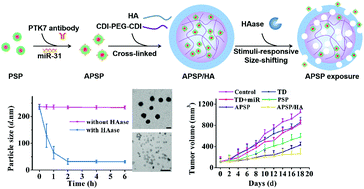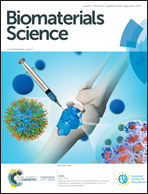A versatile polyion complex can intelligently respond to a tumor microenvironment to eliminate tumor stem cells for enhanced lung cancer targeted therapy†
Abstract
Poor prognosis in lung cancer has been proved to be associated with the presence of lung cancer stem cells (LCSCs). Similar to bulk cancer cells and always existing in the interior of a solid tumor, there are also insurmountable barriers for the elimination of CSCs. To overcome these drawbacks, a versatile polyion complex was rationally designed, which can respond to a tumor microenvironment and exhibits a size-variable property, which allows it to possess remarkable tumor penetration capability and to accumulate around LCSCs. Protein tyrosine kinase 7 (PTK7) antibody mediated active targetability can facilitate the cellular uptake of triphenylphosphine-docetaxel (TD) and microRNA-31(miR-31) and the breakage of the disulfide bond can also enhance intracellular drug release. TD possesses a favorable apoptosis-inducing effect via a mitochondria pathway, while miR-31 could significantly regulate the MET-PI3K-Akt signaling pathway to exert the capability to eliminate LCSCs. APSP/HA might support new insights into LCSC eradiation in cancer management.



 Please wait while we load your content...
Please wait while we load your content...